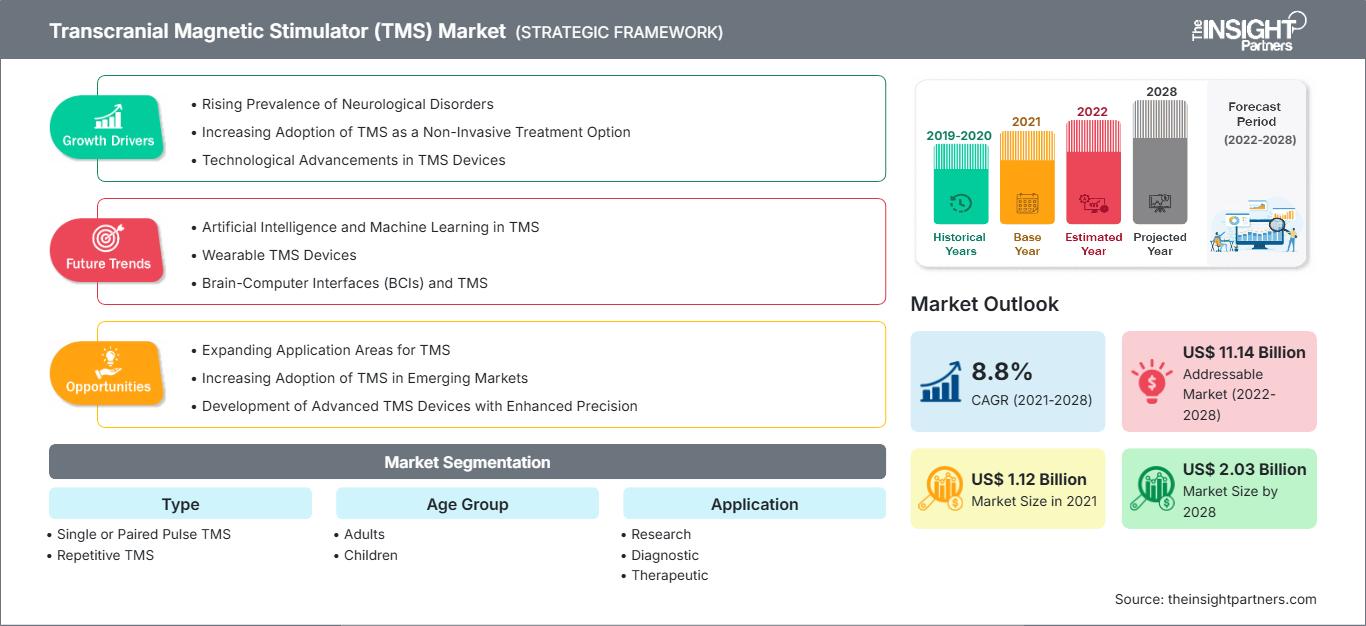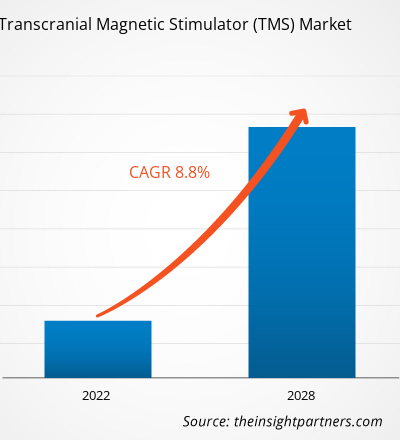[Rapport de recherche] Le marché des stimulateurs magnétiques transcrâniens (TMS) devrait atteindre 2 029,71 millions de dollars américains d'ici 2028, contre 1 122,22 millions de dollars américains en 2021 ; il devrait enregistrer un TCAC de 8,8 % de 2021 à 2028.
Les troubles neurologiques affectent le cerveau et les nerfs du corps humain et provoquent, entre autres, l'épilepsie et les crises d'épilepsie, la maladie de Parkinson, la démence, l'autisme, la maladie d'Alzheimer, les tumeurs cérébrales et la paralysie cérébrale. La prévalence des troubles neurologiques augmente dans le monde entier. Selon l'étude Global Burden of Disease (GBD) de 2017, la maladie d'Alzheimer et d'autres démences [2,55 millions d'années de vie corrigées de l'incapacité (AVCI)], les accidents vasculaires cérébraux [environ 3,58 millions d'AVCI] et la migraine (environ 2,40 millions d'AVCI) étaient les trois maladies neurologiques les plus lourdes aux États-Unis en termes de nombre total d'années de vie corrigées de l'incapacité.
De plus, l'Alzheimer's Association estime que plus de 6 millions d'Américains sont atteints de la maladie d'Alzheimer, et ce nombre devrait atteindre près de 13 millions d'ici 2050. Le stimulateur magnétique transcrânien (TMS) est largement utilisé pour le diagnostic et le traitement des troubles neurologiques. Par exemple, selon BrainsWay Ltd., en avril 2021, 100 000 patients à travers le monde ont été traités avec son TMS profond. Ainsi, la prévalence croissante des troubles neurologiques stimule la croissance du marché mondial des stimulateurs magnétiques transcrâniens (TMS). De plus, la dépression est l'un des troubles mentaux les plus fréquemment observés dans le monde. Selon les données publiées par l'OMS en janvier 2020, plus de 264 millions de personnes de tous âges souffrent de dépression dans le monde.
Vous bénéficierez d’une personnalisation sur n’importe quel rapport - gratuitement - y compris des parties de ce rapport, ou une analyse au niveau du pays, un pack de données Excel, ainsi que de profiter d’offres exceptionnelles et de réductions pour les start-ups et les universités
Marché des stimulateurs magnétiques transcrâniens (TMS): Perspectives stratégiques

- Obtenez les principales tendances clés du marché de ce rapport.Cet échantillon GRATUIT comprendra une analyse de données, allant des tendances du marché aux estimations et prévisions.
Voici quelques exemples de développements :
- En mars 2021, MagVenture a présenté le MagVenture Flow Arm, un système de positionnement clinique en instance de brevet, conçu pour optimiser la mise en œuvre des protocoles approuvés par la FDA de MagVenture pour la technologie de stimulation cérébrale non invasive pour le traitement du trouble dépressif majeur et comme traitement d'appoint du trouble obsessionnel compulsif (TOC).
- En août 2020, la thérapie TMS MagVenture a reçu l'autorisation de la FDA pour le traitement d'appoint du TOC. Il s'agit de la deuxième indication aux États-Unis pour la société danoise de dispositifs médicaux MagVenture.
- En février 2019, eNeura, Inc., une société privée de technologie médicale, a annoncé une nouvelle autorisation 510(k) de la FDA. Avec cette autorisation, la société a affirmé que le sTMS est le seul produit contre la migraine aux États-Unis pour le traitement des migraines aiguës et prophylactiques chez les adultes et les enfants (12 ans et plus).
Ainsi, la participation active des acteurs mondiaux au développement de la stimulation magnétique transcrânienne et des technologies associées devrait soutenir la croissance du marché.
Informations basées sur le type
En fonction du type, le marché des stimulateurs magnétiques transcrâniens (TMS) est segmenté en TMS à impulsions simples ou appariées et en TMS répétitive (rTMS). En 2021, le segment TMS à impulsions simples ou appariées détenait une part de marché plus importante. Cependant, le segment TMS répétitif (rTMS) devrait connaître un TCAC plus élevé entre 2021 et 2028.Informations basées sur les applications
En fonction de l'application, le marché est segmenté en recherche, diagnostic et thérapeutique. En 2021, le segment du diagnostic détenait la plus grande part du marché et devrait croître au TCAC le plus élevé au cours des prochaines années. Les entreprises opérant sur le marché des stimulateurs magnétiques transcrâniens (TMS) mettent l'accent sur l'adoption de la stratégie d'innovations de produits pour répondre à l'évolution des demandes des clients à travers le monde, ce qui leur permet également de maintenir leur nom de marque sur le marché mondial.Marché des stimulateurs magnétiques transcrâniens (TMS)
Les tendances régionales et les facteurs influençant le marché des stimulateurs magnétiques transcrâniens (TMS) tout au long de la période de prévision ont été analysés en détail par les analystes de The Insight Partners. Cette section aborde également les segments de marché et la répartition géographique des stimulateurs magnétiques transcrâniens (TMS) en Amérique du Nord, en Europe, en Asie-Pacifique, au Moyen-Orient et en Afrique, ainsi qu'en Amérique du Sud et en Amérique centrale.Portée du rapport sur le marché des stimulateurs magnétiques transcrâniens (TMS)| Attribut de rapport | Détails |
|---|---|
| Taille du marché en 2021 | US$ 1.12 Billion |
| Taille du marché par 2028 | US$ 2.03 Billion |
| TCAC mondial (2021 - 2028) | 8.8% |
| Données historiques | 2019-2020 |
| Période de prévision | 2022-2028 |
| Segments couverts |
By Type
|
| Régions et pays couverts | Amérique du Nord
|
| Leaders du marché et profils d'entreprises clés |
|
Densité des acteurs du marché des stimulateurs magnétiques transcrâniens (TMS) : comprendre son impact sur la dynamique des entreprises
Le marché des stimulateurs magnétiques transcrâniens (TMS) connaît une croissance rapide, portée par une demande croissante des utilisateurs finaux, due à des facteurs tels que l'évolution des préférences des consommateurs, les avancées technologiques et une meilleure connaissance des avantages du produit. Face à cette demande croissante, les entreprises élargissent leur offre, innovent pour répondre aux besoins des consommateurs et capitalisent sur les nouvelles tendances, ce qui alimente la croissance du marché.
- Obtenez le Marché des stimulateurs magnétiques transcrâniens (TMS) Aperçu des principaux acteurs clés
- TMS à impulsions simples ou appariées
- TMS répétitive (rTMS)
Par tranche d'âge
- Adultes
- Enfants
Par application
- Recherche
- Diagnostic
- Térapeutique
Par géographie
- Amérique du Nord
- États-Unis
- Canada
- Mexique
- Europe
- France
- Allemagne
- Italie
- Royaume-Uni
- Espagne
- Reste de l'Europe
- Asie-Pacifique (APAC)
- Chine
- Inde
- Sud Corée
- Japon
- Australie
- Reste de l'APAC
- Moyen-Orient et Afrique (MEA)
- Afrique du Sud
- Arabie saoudite
- Émirats arabes unis
- Reste de la MEA
- Amérique du Sud et centrale (SCAM)
- Brésil
- Argentine
- Reste de la SCAM
Profils d'entreprise
- BrainsWay Ltd
- Nexstim, Magstim
- Neuronetics
- TMS Neuro Solutions
- MagVenture, Inc.
- eNeura Inc.
- Neurosoft
- MAG & More GmbH
- Analyse historique (2 ans), année de base, prévision (7 ans) avec TCAC
- Analyse PEST et SWOT
- Taille du marché Valeur / Volume - Mondial, Régional, Pays
- Industrie et paysage concurrentiel
- Ensemble de données Excel
Rapports récents
Témoignages
Raison d'acheter
- Prise de décision éclairée
- Compréhension de la dynamique du marché
- Analyse concurrentielle
- Connaissances clients
- Prévisions de marché
- Atténuation des risques
- Planification stratégique
- Justification des investissements
- Identification des marchés émergents
- Amélioration des stratégies marketing
- Amélioration de l'efficacité opérationnelle
- Alignement sur les tendances réglementaires




















 Obtenez un échantillon gratuit pour - Marché des stimulateurs magnétiques transcrâniens (TMS)
Obtenez un échantillon gratuit pour - Marché des stimulateurs magnétiques transcrâniens (TMS)